Abstract
The paper at hand is aimed at examining the process of cars recycling in the context of energy use. It is considered critical to elucidate this problem and find the alternative solutions that might assist in minimizing the negative impact of the recycling.
The core theme of the paper is the comparative analysis of steel and aluminum and the advantages of these materials from the recycling perspective. The problem is examined both generally and applying to the German economy.
The paper provides a detailed overview of the relevant literature and points out the existing gaps. A particular focus is put on the analysis of two case studies. The first study has economic implications. Thus, it evaluates the possibilities of replacing relatively cheap steel by costly aluminum with the view that the latter is more environmentally-friendly. The study proposes an explicit worth analysis of the proposed change.
The second case study puts an emphasis on the environmental side of the problem. Hence, it offers a comparative analysis of steel and aluminum in terms of the impact that they have on the environment when being recycled. The study illustrates the benefits of the latter and outlines two potential scenarios of the change implementation.
The pivot of the paper at hand is the proposal description. Thus, it offers guidance for replacing steel with aluminum and assesses potential outcomes for the two scenarios.
The discussion part of the paper summarizes the received findings and draws the relevant conclusions. It overviews the arguments supporting the replacement of steel and outlines the framework for future research. Thence, it is recommended that the existing study is further extended in order to study the impact of the proposed implementation in the context of the German economy. All the tables and statistical figures are provided in the appendix and can be employed for future investigation.
Introduction
In the last 20 years, manufacturing automobile has increased dramatically where it is been counted that the number of manufactured cars in 2015 has reached to 90,780,583 units [1]. The Organization for Economic Cooperation and Development (OECD) has estimated an increase of 32% in the total number of vehicles between 1997- 2020 in OECD nations. Moreover, the number of passenger cars every year is being increased in the Europe. Where the total car production has reached 15 million cars by the end of year 2014 [2].
Automobiles are crucial to society and constantly being used. Yet they have a huge impact on environment during its life cycle. The energy, resources, the waste that is being generated during the manufacturing and using phase and the disposal at the end of the useful life of the vehicles is huge. In 2010 is being counted that 14% of the global greenhouse gas emissions comes from the transportation sector as most of the world’s transportation energy is from fossil fuels [3].
Recycling concept of the cars does incorporate the recycle, reuse and recovery. The main motivation behind the recycling comes from various elements that have changed with time. For instance, in 1960s–1970s the advancement of the electric curve heater, which lead to expand in usage of shells as input scrap. Then, production of high quality steel and further, the division and recuperation of aluminum from end life vehicles were more viable and energy efficient than creating of aluminum from its minerals. Recycling vehicles have more environmental and social benefits than economic and technological elements. The automobile business is moving toward sustainable waste management.
Recycling is being identified with the material utilized for vehicle producing. Vehicle structure has been moving toward light materials, for example, aluminum and polymeric constituents. As according to Zoboli et al. [4], the aggregate weight of 1965 European automobile included around 82% ferrous and non-ferrous metals (2% aluminum) and 2% plastics. Where in the mid of 1980 the substance of ferrous and non-ferrous metals arrived at the midpoint of 74–75% (with 4.5% aluminum) and plastics were assessed at 8–10% of a European automobile’s weight.
The use of aluminum and plastics enhanced the fuel consumption and reduce the greenhouse gas emissions as well. The figure (1) below shows the composition of the European Union car in 1998. The aluminum is around 8% of the total car weight, where other metals (Zinc, Copper, Magnesium and Lead) are around 67.5 % of the car’s total weight. The figure also illustrates the plastic usage in the case where it consist around 9.3%, the plastic can be used in the car body. While in year 2000, the aluminum has increased in average in Western Europe the automotive parts included 102Kg of aluminum. 59Kg used in engine parts, 6Kg in chassis applications, another 11 Kg in structural parts and 5Kg in the body [5].
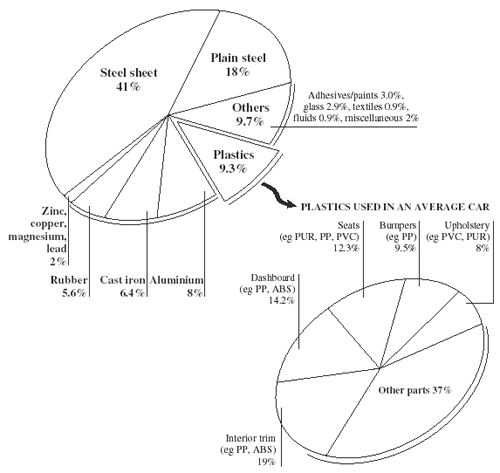
Roughly 86 percent of a vehicle’s material substance is reused, recycle or utilized for energy efficiency as appeared in Figure (2) [6]. The main motivation behind this research is to analyze the economic benefit of using recycle cars using the cost and benefit analysis approach. Moreover, to look how the designs of cars does affect the greenhouse gases emission and fuel consumption.

The disposal of End-of-Life Vehicle (ELV) is shown in the Figure (3) from starting with the automakers till it reaches to the shredder. The car users are the beginning stage of the ELV cycle. The users after de-registering the cars can give their cars to merchants or used car dealers. After that, the dealers will send the car to the collectors.

There are around 9 million ELV that are being reused in the Europe [7]. Collecting organizations concentrate on removing significant extra parts and others, for example, batteries, engines, oils and airbags. Despite of the fact that these organizations are key to the lessening of ELV waste, they are little organizations that are for the most part intrigued by ELV parts that are appropriate for selling, reusing and recycling.
The disassembling of the ELV is usually done badly, as the number and danger of ELV waste increase. After the disassembling done, the leftovers of the ELV are called hulks, which are taking cared by other organizations the shredding companies. The following step is when the hulks are destroyed, the material obtained goes into the progress of mechanical and physical detachments keeping in mind the end goal to recoup the ferrous and non-ferrous metals. The process of the shredding which is called automobile shredder residue (ASR), is around 20–25% of the ELV weight. Moreover, it is being counted that the ELV recyclable rate of 75–80% is higher than other products like daily papers and aluminum drink cans [7].
In recycling the ELV the weak point is considered to be the ASR, where around 2millions tones are being generated every year in Europe [7]. Another point to be noticed that the cost of dispose of ASR in the landfill is expensive in Germany as appeared in table (1). Moreover, uncertainties in the price of steel scraps and the high ASR treatment cost have now reduced the ELV costs. Therefore, the ELV recycling regulations should be explained which will have a huge impact in the automobile industry and the economy of Germany.
Table 1 ASR Landfill Costs.
When we speak about car recycling, Germany is considered to be one of the leading country in producing and using recycled cars. Companies from different divisions in Germany started to establish policies to reach the environmental target since 1990 [8]. Moreover, a report in the EU-27 has shown an increase of end of life vehicles sharply from 6.3million in 2008 to 9 million in the following year 2009.
It is being noticed from the table (2) that Germany is the main contributor to that increase, as in 2008 the number of vehicles was 4 thousand and in 2009 it has reached to 1.7 million. However, after 2009 the number of vehicles has decreased and that was mainly because of the scrapping concept that is been introduced by the countries due to the financial crisis in 2008 and 2009 [9].
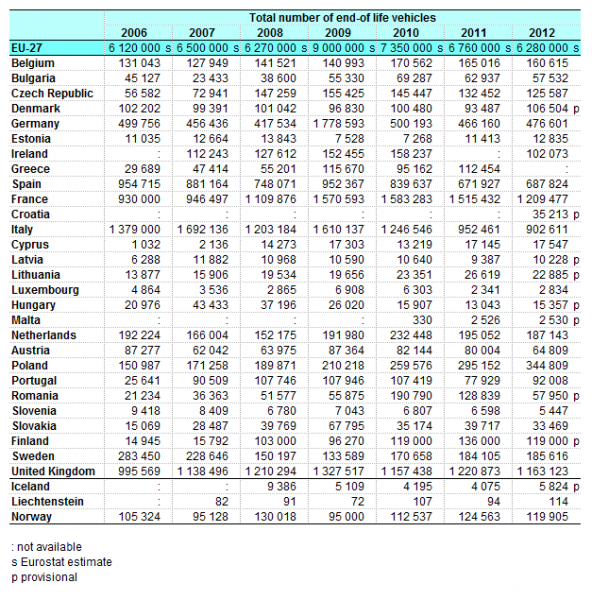
Literature Review
In the context of contemporary research in the field of energy and recycling, there are a number of studies focused on direct and indirect energy use. However, in terms of a specific perspective of analyzing energy and recycling implications, it is important to collect different data, finding, and methodological parameters regarding the issues of minimization emissions from the global car stock, specifics of energy and recycling conditions of German automobiles, the recycling opportunities within their vehicle systems, as well as the taxation and other legal implications related to them.
First of all, according to Stodolsky, Vyas, Cuenca, and Gaines (1995), among the issues that are concerning both the global level of car recycling and German industries specifically, in which case, it is important to consider the disposition of weight of the car (Stodolsky et al., 1995). Stodolsky et al. (1995) also suggest that one of the potential dangers of lack of attention to how minimizing the weight of a car can reduce energy consumption and improve various aspects of the recycling process is that this issue is most overlooked in passenger cars (Stodolsky et al., 1995).
Moreover, Marlen, Kennethand, and Georg (2009) found that it can also be suggested that all the potential for energy and economic savings in many ways can depend on light-weighting of automobiles (Marlen, Kennethand, & Georg, 2009). A special area of concern is, of course, passenger car since they represent a major share of the current vehicle market, with an approximate market share of 40 to 45% (IPCC, 2007).
For that reason, it is also important to point out that in contemporary vehicle market in Germany, there is a special concern over not only the growing emissions of greenhouse gasses but also over finding efficient ways of recycling vehicle parts in such a way that there is as little waste as possible. In relation to this, Orsato, Hond, and Clegg (2002) note that the specific culture of political ecology in Europe views energy and recycling implications related to passenger automobiles as one of the priorities of improving the overall ecological situation (Orsato, Hond, & Clegg, 2002).
According to Schmidt et al. (2004), in order to understand the results of car recycling, it is important to analyze the constituencies of a typical German passenger vehicle, its composition and materials used; in the current market, in standard automobile of such kind, there is 60-75% of metal and alloys, specifically aluminum the total car weight (Schmidt et al., 2004). At this point of automobile manufacturing development, such disposition implies that any process of recycling would require the precise knowledge of all the constituencies of a vehicle. However, in the context of German car market, the process is currently improving, particularly, the production process starts with using materials that are:
- more recyclable,
- more light-weight.
In such a way, in the majority of European countries, there are a number of regulations regarding the specifics of transitions towards light-weight passenger cars. In relation to this issue, the findings of Allwood et al. (2012) showed on the basis of a detailed analysis that the most frequently used materials in car manufacturing (which are aluminum, steel, and their alloys) can also be utilized in different sectors of the economy (Allwood et al., 2012). Allwood et al. (2012) also found that the approaches, similar to those that are used in Germany regarding the implementation of more recyclable and more light-weight cars can reduce negative effects of both waste materials and energy consumption at the global level (Allwood et al., 2012).
On the other hand, in the situation, where a variety of implication depends on the particular set of policies exercised by the governments, it is also important to take such variables as taxation of passenger vehicles and general political agenda towards environmental policies into consideration. In such a way, according to the findings by Schmidt et al. (2004), there should be an assessment of the linkage between lightness and recyclability of a vehicle (Schmidt et al., 2004). As a result, it is possible in Germany and some other European countries to regulate the criteria of car assessment, as well as requirements for a vehicle, depending on more specific circumstances.
Finally, it is also important to mention the findings of Orsato, Hond, and Clegg (2002), who found that it is more efficient when different types of recycling correspond to different purposes (Orsato, Hond, & Clegg, 2002). For example, on one hand, while such type of recycling that is accepted in the countries of EU as ELV shows a certain level of customer-specific appeal, therefore, can be more effective in markets with less regulation and taxation, VDA and BMU, on the other hand, revealed better results in terms of recycling efficiency in other circumstances (Orsato, Hond, & Clegg, 2002).
In Germany, the ELV laws determine the majority of recycling regulations in the sphere of vehicle manufacturing. In particular, the taxation of the manufacturers depends on not only such factors as price and place in the market but also on car weight and its efficiency in terms of recyclability.
Case Study
Economic Study
A significant dilemma is increasing the amount of aluminum in order to light-weight the vehicle and reduce greenhouse gas emissions [1]. However, the much higher cost of aluminum compared with steel has made it difficult to achieve vehicle light-weighting. One of the goals of this project is to conduct a cost and benefit analysis of replacing less expensive steel with more expensive aluminum. These are the important differences between steel and aluminum [2]:
Table 1: Al and Steel differences.
It is clear that aluminum is almost three times lighter than steel, but also about four times more expensive than steel. The breakdown of the costs will be discussed in the next section.
Costs
The total cost can be broken down into two parts, pre-manufacturing and manufacturing [3].
Pre-manufacturing cost is the material production cost, which includes resource extraction and primary material processing activities. Activities such as mining of minerals, their transportation from virgin ore sites to the first refining processes, and fabrication of raw materials (e.g., sheet, extrusions and castings) are highly energy-intensive and also not environmentally friendly at all, resulting in several environmental and societal consequences.
Manufacturing costs involves producing and assembling the parts into sub-assemblies. High energy is required to power and operate the forming and stamping machinery, which transform the raw material into automotive parts and the assembly of parts into subassemblies by joining or fastening operations. The operation of machines, use of different cooling compounds for work material, and the processes of forming and trimming result in production of solid and liquid wastes. There is active research being done as to how these waste products can be continuously recycled and reused. As a result, the only environmental pollutants in this manufacturing stage are the gases released from the usage of electricity.
Car Model
It is important to discuss about the model of the car, in order to simplify the analysis, and establish the important variables that will allow us to determine the total weight of the car. The weight of the car can be divided into primary, secondary and tertiary components [4]. The primary weight of the car is assumed to be equal to the weight of the body-in-white(BIW), which is the actual skeletal frame of the car. The BIW can be molded out of wrought aluminum or steel. A model car’s BIW is shown below:
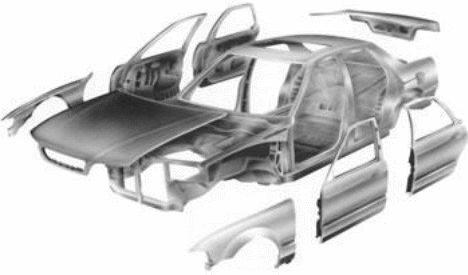
The secondary components include all those components whose weight depends on the BIW’s weight. These include components such as engine, suspension and other important components that impact drive-ability of the car. Secondary components are assumed to be made of steel or aluminum only. If aluminum is used to construct the engine, cast aluminum would be used. The dependence of its weight on BIW means that the secondary weight will change with a change in the BIW weight in order to keep the same efficiency and standards, for e.g. if BIW is reduced from 400kg to 290kg by replacing steel with aluminum, secondary components weight would be reduced from 70kg to 53kg.
The tertiary components include all parts of the car that are not included in the primary and secondary category, and they are not made of either steel or aluminum, but of other materials. These include parts such as safety systems, electrical systems, windows, dashboards, and other interiors. The important point to note is that a change in BIW weight will not affect the tertiary weight at all.
Summarizing the car model, the main takeaway is that aluminum or steel weight is part of primary and secondary components only. Tertiary components do not use steel or aluminum. This means that we can neglect tertiary components when analyzing the weight of the car. The analysis error due to this neglect would be small because tertiary components account for less than a third of the car weight.
Methodology
The tool that we have used in order to deduce the feasibility of this study is the cost and benefit analysis tool. This tool helps evaluate both environmental and economic costs, and help make a decision, potentially also influencing government policy [5]. The important features of this tool are as follows:
- Benefit is defined as gain, and cost as loss of well-being;
- Benefit is measured by willingness of individual to pay or accept;
- Cost is measured by tolerance of loss of an individual and prevention;
- Projects, policies and programs are considered acceptable if B-C ≥ 0;
- Benefits and costs stretch out over time.
Technically, CBA considers cash flow stream of benefits and costs over duration in time.
- If B/C ≥ 1, it suggests that the extra benefits of the high cost alternative justify the higher cost alternative.
- If B/C ≤ 1, it suggests that the extra cost is not justified, and the lower cost alternative is selected.
- If B/C < 0, reject the policy.
- If B/C > 0, accept the policy.
Economic Analysis Techniques
Economic techniques help us evaluate a set of feasible alternatives, which we can use to determine the most economically efficient policy in terms of the solution criteria. In our case, we use two such techniques, described below:
Present Worth Analysis
Present worth analysis is also known as Discounted Cash Flow, Present Value, or Net Present Value analysis. It’s a common tool used by the government, and it converts all future cash flows into present currency equivalents. As a result, it is easy to determine the economic efficiency of one alternative to another.
There are three criteria that apply to this technique:
- For fixed input situations (maximize the PW benefits or other outputs)
- For fixed output situations (minimize the PW costs or other inputs)
- Neither input or output fixed (maximize net PW = PW benefits – PW costs)
Annual costs, future payments, and gradients must be brought to the present. Converting all cash flows to present worth is often referred to as discounting.
In the discounting equation, the expression
is called the present worth factor and is represented by the symbol (P/F, i, N). Thus, for the present worth of a future sum at i percent interest for N periods:
Or calculated Net Present Value using:
Where B = benefit, C = cost, i = discount rate over time
If the NPV of a particular project is greater than NPV of the alternative, then the project should be opted for, else the alternative is chosen.
Plots and Tables
The following plot shows the total cost varying with the amount of aluminum, where we can see that the cost rises linearly with the aluminum content.
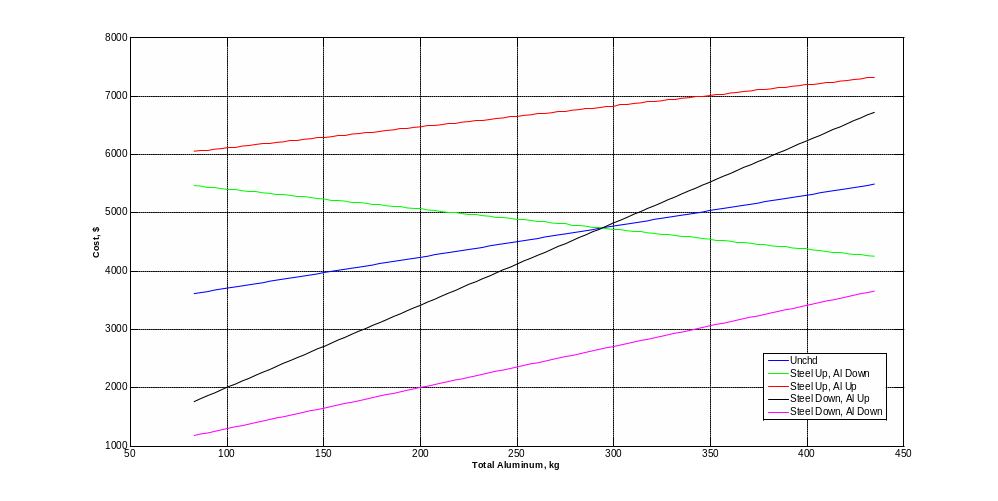
The key point to note is that the difference between the highest and lowest prices is about $1875, which is almost $2000, and can be considered quite expensive for a customer looking for an inexpensive car. This difference is mainly due to the high cost of aluminum itself.
The second plot shows the total cost with the tax model added:
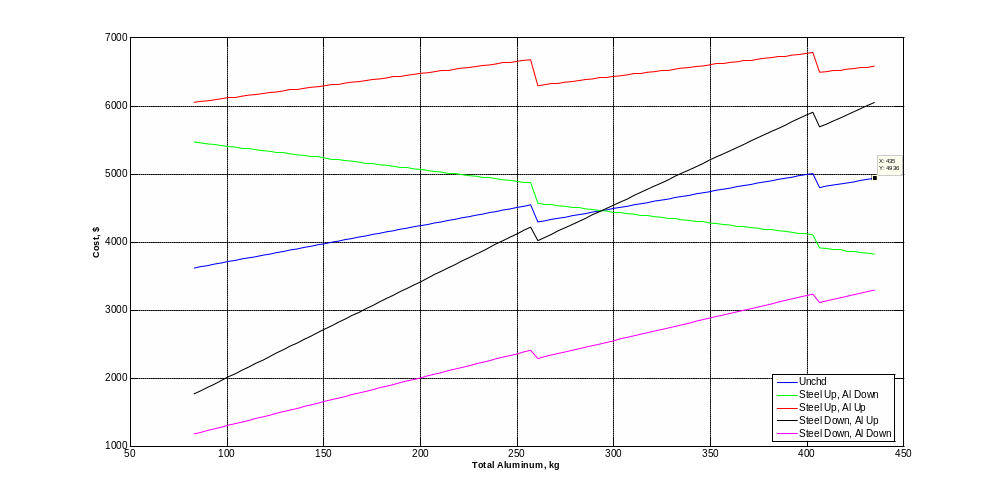
Once the tax model is added, the difference in the highest and lowest price drops to $1320, a decrease of about $550 from the base case. However this price difference might still not convince buyers to go for a high aluminum content car, so they need to be made aware of another important saving measure – fuel consumption.
The following two tables calculate the present value of fuel cost saved over a period of 10 years. The two key variables are the quantity of aluminum (high or medium reduction), and the volatility of fuel prices.
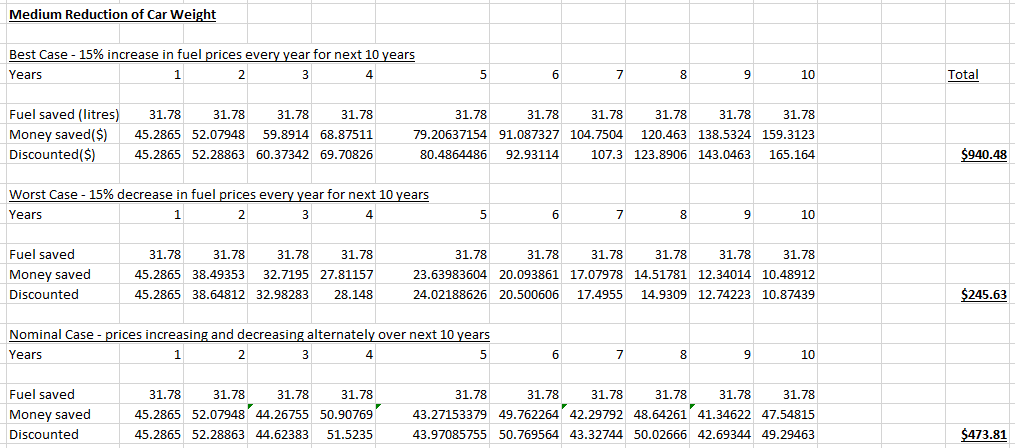
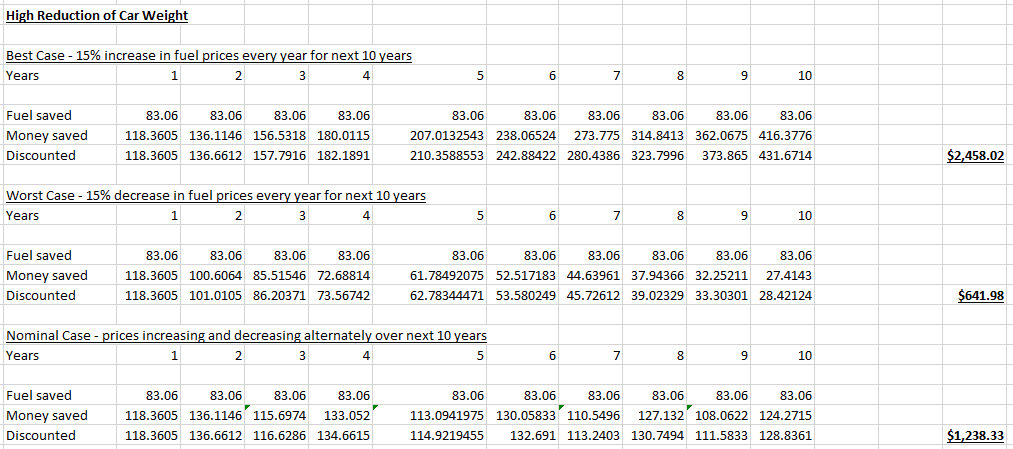
The parameters chosen are as follows:
- A period of ten years is chosen as the timeframe over which the car will be used and fuel will be saved due to light-weighting.
- The discount rate is set to -0.4%, which is the interest rate set by the European Central Bank for Eurozone and therefore Germany [6].
- Fuel price in Germany is $1.425/liter [7].
- Average yearly volatility of fuel prices is calculated to be 15% from EIA table [8]. Best case savings result from prices increasing by 15% every year, while worst case savings result from 15% price decrease every year. Nominal scenario is also calculated wherein the price stays almost unchanged after 10 years.
Once we have the discounted amounts, we compare these amounts to the aluminum-steel cost differences from the plots for the two scenarios, medium reduction and high reduction. Using the plots, medium reduction corresponds to 281kg of aluminum, while high reduction matches with 435kg of aluminum. The cost difference and net savings are shown in the following tables:
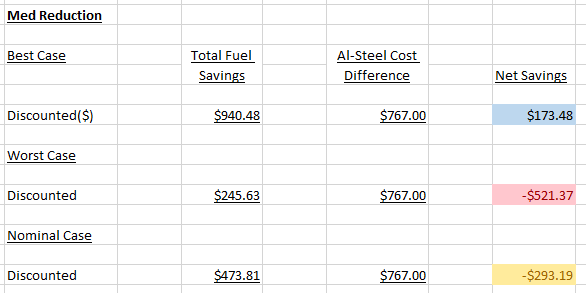
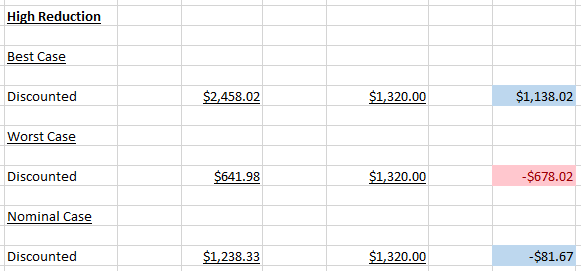
Envionmental Study
The environmental impact is the main feature of the project. The implications for the environment that the substitution of steel for aluminum are many, and it affects deeply to all the life cycle of the vehicle, from its fabrication, to the energy consumption during its use and its deploying once its life cycle is finished.
When a product is considered as efficient it is normally considered only due to its performance when it is in use, but the energy used during its production is rarely included in the concept of efficiency. In many cases the amount of energy used during the fabrication of the product is several times the amount of energy that the product uses when it is working. One example of this dichotomy are photovoltaic panels, which use a huge amount of energy during its production while the electricity that they generate is carbon free.
The material that a car is made of makes a big difference in terms of energy consumption for its fabrication process in terms of energy consumption. Being steel more energy consuming than aluminum.
Table 1. Energy consumption of production of Al and steel.
The energy consumed by new aluminum might be surprising, but the amount of non-recycled aluminum in a car is very limited due to the high index of recyclability of this material.
Table 2 Percentage of aluminum and steel available to recycle.
As can be seen in the tables above, not only aluminum is more desirable from an energetic point of view, but it is also more desirable given that more product is going to be able to be reused after its life cycle.
We are going to study the applicability of this measure in a European country where the recycle rate of cars is very high, such as Germany according to the statistics given by the UE. In this way the effect of the new policy will be amplified by the high recycle rate of the cars in Germany.
Table 3 Yearly recycling rate in different European countries.
Fuel consumption
The introduction of aluminum in the car will make it lighter, affecting the fuel consumption of the car. For the study of the carbon dioxide emissions savings we are going to suppose that the cars in Germany make an average of 15000 km a year, with 80km trips. The average speed in such trips is 100 km/h.

We have assumed the same parameters as the ones assumed by Dr. Alejandro Rios in the second homework of this subject. Considering them as good and relying on his criteria. For the calculations of the power needed by three different cars we are going to assume three different types of cars.

Table 4 Aluminum and Steel composition for different cars.
Table 5 Annual energy usage for each type of car.
The calculations for table 5 have been done assuming a 25% engine efficiency [REFERENCE]. As can be seen in the results, the fuel consumption is affected notably when the car is lighter. Over the lifetime of a vehicle the amount of money saved by making vehicles lighter can be of several thousands of dollars.
The next step is analyzing how the introduction of lighter cars with lower weight and enhanced recyclability would affect the emissions produced by the transport sector of a whole country. We are going to compare 3 hypothetical scenarios, as explained in the table below.
Table 6 Different scenarios.
Table 7 Total number of cars and new cars annually in Germany (in thousands).
As can be seen in the table above the number of cars bought in Germany has been constant during the 2009-2013 five year period. For our 10 year study we are going to assume that the number new cars is going to be 2.8 million annually and that it is going to remain constant. From the official information of the European Union we can see that this simplification is accurate and it simplifies the calculations.
Regarding the number of cars decommissioned each year, it can be seen that it is smaller than the number of new cars, hence the car stock of Germany increases gradually over time at a constant rate of half a million cars a year. We are going to assume that this tendency is going to continue also over the ten year period of this project and the error will be small.
With this assumptions a study of the emissions due to fuel consumption during a 10 year period can be done for the three scenarios described in the table.
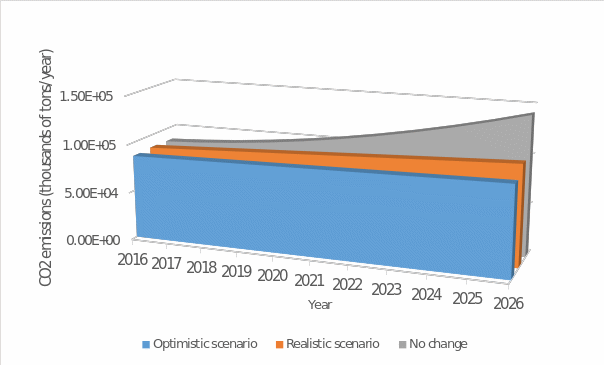
Table 8 decrease in carbon dioxide emission due tu fuel consumption.
Save in emissions in the recycling process
It is not only the fuel consumption the parameters that makes more attractive to increase the percentage of aluminum in the car. The recycling and production process is also favored by this change in the materials the car is made of.
The energy demand of production of this materials is different if they are produced from scratch or if they are recycled as can be seen in the following table. In this study we are going to focus in the substitution of steel for aluminum.
Not all the materials can be recycled totally at the end of the life cycle of a vehicle. Some materials can be recycled more than others, in the following table the data of the recyclability of some materials is given.
Table 9 Recycle rates of different materials.
We are going to consider the energy consumption of the production of the total aluminum and steel for the different types of cars that we are supposing for this project. In the following tables the energy consumption of this materials for each car is calculated. We take into consideration the recyclability of this materials as well as the total recycle rates of Germany in order to come with this results.
Table 10. Energy consumption for steel and Al for a low Al car.
Table 11 Energy consumption for steel and Al for a medium Al car.
Table 12 Energy consumption for steel and Al for a high Al car.
For the calculations of the CO2 emissions in the tables above the overall efficiency of the German electric sector has been taken into consideration. In this way we can consider the primary energy consumed and consequently the emissions.
Based in this calculations for each car we can study the impact of this saving in energy for the country for the two scenarios in which cars with high content of steel are replaced by cars with more aluminum.
Table 13 CO2 emissions yearly due to the fabrication of cars.
Results & Discussion
Conclusions
In conclusion, substituting the steel with aluminum in cars will reduce the fuel consumption and greenhouse gases. As we can save up to 3 million tons in the manufacturing of the cars and we can also reduce up to 30% of co2 emissions due to fuel consumption after 10 years. An interesting result is that volatility analysis demonstrate that as the aluminum price increase the overall price of aluminum will be reduce as a function of aluminum weight.
Future Work
Based on our findings, future work should be focused on the effect that manufacturing lighter aluminum cars will have in the economy of Germany since we are implementing lower tax on high aluminum cars.
References
“Production Statistics | OICA“, Oica.net, 2016. Web.
“ACEA – European Automobile Manufacturers’ Association”, Acea.be, 2016. Web.
“Global Emissions | Climate Change | US EPA“. 2016. Web.
R. Zoboli et al., “Regulation and Innovation in the Area of End-of-Life Vehicles,” EUR 19598 EN, ed. F. Leone (Milan, Italy: IDSE-CNR, 2000).
“Automotive Trends in Aluminum, The European Perspective: Part One :: Total Materia Article“, Totalmateria. 2016. Web.
Duranceau, C. and Sawyer-Beaulieu, S. (2011). Vehicle Recycling, Reuse, and Recovery: Material Disposition from Current End-of-Life Vehicles, SAE Technical Paper.
“End-of-Life Vehicle Recycling in the European Union”, Tms.org, 2016. Web.
R. Lucas, “End-of-life vehicle regulation in Germany and Europe,” 2001.
End-of-life vehicle statistics – Statistics Explained“, Ec.europa.eu, 2016. Web.
J. M. Allwood, J. M. Cullen and M. A. Carruth, “Sustainable Materials with Both Eyes Open”, UIT Cambridge Limited, 2012.
Allwood, J. M., Cullen, J.M., Carruth M.A., Cooper D.R., McBrien M., Milford, R.L., Moynihan M., & Patel A.C.H. (2012). Sustainable Materials: with both eyes open. Cambridge, United Kingdom: UIT.
IPCC. (2007). Transport and its infrastructure. In Climate Change 2007: Mitigation. Contribution of Working Group III to the Fourth Assessment Report of the Intergovernmental Panel on Climate Change. Cambridge: Cambridge University Press.
Marlen B., Kenneth J.M., & Georg R. (2009). Material Flow Analysis in the Aluminum Industry. Journal of Industrial Ecology 13(5), 650–654.
Orsato, R. J., Hond, F., & Clegg, S. R. (2002). The political ecology of automobile recycling in Europe. Organization Studies, 23(4), 639-665.
Schmidt WP, Dahlqvist E, Finkbeiner M, Krinke S, Lazzari S, Oschmann D, Pichon S, Thiel C. (2004). Life Cycle Assessment of Lightweight and End-of-Life Scenarios for Generic Compact Class Passenger Vehicles. International Journal of Life Cycle Assessment, 9(1), 405–416.
Stodolsky, F., Gaines, L., Cuenca, R., & Vyas, A. (1995). Life-cycle energy savings potential from aluminum-intensive vehicles. Warrendale, Pennsylvania: SAE.